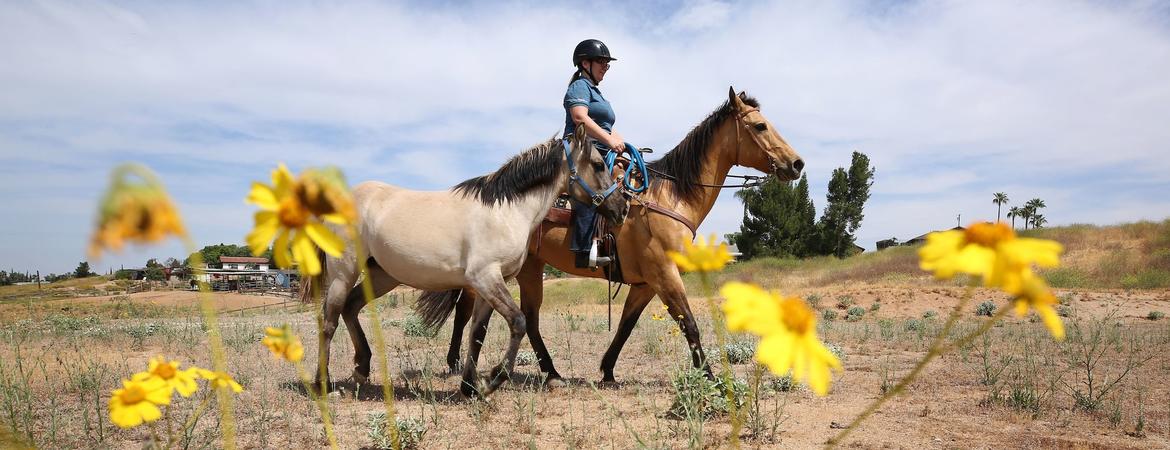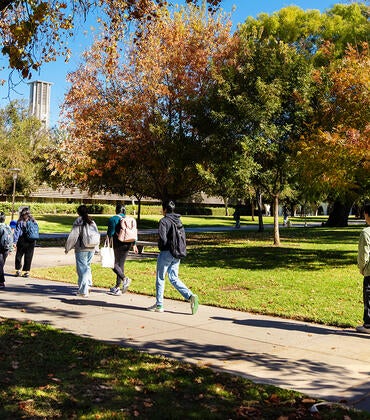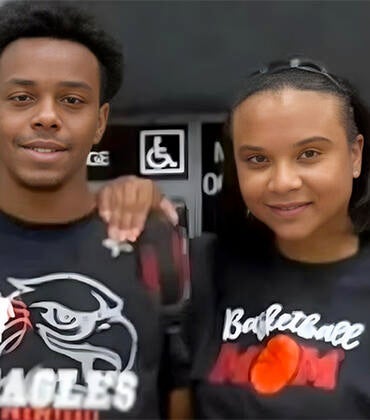
For Kat Boniface, the history of horses goes far beyond the famous thoroughbred.
Boniface, a doctoral student in the history department at the University of California, Riverside, arrived at UCR in 2015. Since then, she’s narrowed the focus of her research from medieval history to horses and horsemanship, topics in a rising field known as equine history.
As unconventional as her research field is the route Boniface took to UCR.
Raised in North Hollywood, she began her undergraduate studies at Stony Brook University in New York. Midway through, she changed course, opting instead to pursue a trade degree from Meredith Manor, an equestrian college in West Virginia that trains students for hands-on careers with horses.
“It was boot camp,” Boniface said of her time at the college. “We worked long days; cleaned stalls; rode; trained; and learned basic veterinary treatment, when to call a vet, and even how to forge and make horseshoes.”
After earning her degree, Boniface helped run a 128-acre horse farm in Maryland, where she handled and trained about half of the farm’s 60 horses and taught riding lessons.
Ultimately, however, she’d return to Stony Brook, graduating in 2013 with a bachelor’s degree in history and earning a master’s degree from California State University, Fresno, in 2015. Still, her lifelong passion for working with horses stuck — fueled, in large part, by her experiences at the trade school and as a trainer.
She came to UCR determined to translate her interest into research, and quickly found mentors in history professors such as Randolph Head, Jonathan Eacott, and Dana Simmons.
Within the larger field of animal history, Boniface now studies several aspects of humans’ interaction with horses, including breeding, training, and nutrition.
She also tracks the historical evolution of what people’s humane treatment of horses has entailed, noting that what might’ve passed for “humane treatment” in the 18th century, for example, could be wildly different from what’s considered humane today.
“How we define humane treatment makes us reconsider our relationships with animals, but it also makes us reconsider our relationships with other people,” Boniface said. “It’s especially relevant because the same discussions are happening right now about how we should treat people, especially those who have less power than others.”
More recently, Boniface has explored the development of the definition of what a “breed” is.
Early uses of the word “breed” in relation to horses date back to the 1700s. Back then, government-managed breeding programs called “state studs” were established to produce elite animals — mainly for military use — but also invited farmers to share in their use to improve the general population of horses. State studs later inspired the development of the U.S. Army Remount Service, a breeding program launched in the early 20th century to provide horses for the U.S. Cavalry.
But between the 1700s and the 1950s-60s, the meaning of the word “breed” changed dramatically, Boniface said. Its modern meaning is more likely to connote strictness of pedigree and bloodline rather than the mere intention to produce animals for use.
Around the world, “breed” still carries nuances reflective of place as well as time.
In the U.S., one breed of horse, the standardbred, has been used for centuries in the farming, industry, and military sectors. It’s also the “root stock” behind many other American breeds, Boniface said.
“One of the things I’ve found is that our definition of breed and the way we think about breeds is almost uniquely American,” she said. “The U.S. has so many more breeds than average, often with their own regional identities, histories, and mythologies. I think a lot of it is tied up in Western expansion; every time the frontier moved, we had new formations of identity that became tied up in the animals people were producing.”
Likewise, the frontiers of equine history are broad, with the field incorporating horse racing, veterinary history, archaeology, and genetics, among other areas.
To unite practitioners of equine research around the world, Boniface founded the nonprofit Equine History Collective in 2016. The organization, dedicated to the study of the role of horses across societies and cultures, boasts more than 100 members. Boniface organized its first annual conference in November 2018, an event held at the W.K. Kellogg Arabian Horse Library at California State Polytechnic University, Pomona.
Animal studies continue to grow in popularity, she said, and the success of the Equine History Collective has already inspired the development of a similar organization dedicated to dog history. The organization will likely be based out of Kansas, led by a researcher who studies the K-9 Corps, a program created during World War II to provide the U.S. Army with war dogs.
For now, Boniface still makes time to ride a couple of times a week at Riverside’s Moon Dance Ranch. After earning her doctorate, she wants to teach, “whether it’s at a university, a barn, or somewhere like an agricultural extension center,” she said.
Through her research, she hopes to make a case for “history as ethics” — a means of asking why we do what we do and questioning stereotypes, such as the age-old myth of chestnut-colored mares being notoriously cranky.
“I used to assume that once a book had already been written on a topic, all the questions were answered,” Boniface said. “But that’s not really how history works. There’s always more to learn, there are always other ways to look at things, and there’s always new information being found that challenges the way we see the past."



